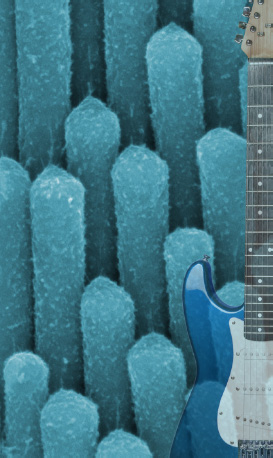A Tuning Gear for the Tip Link
To elicit sweet, crowd-pleasing notes as they strum, guitarists need to keep the tension on their guitar strings sufficiently tight, which is adjusted at the tuning gear. Similarly, for you to be able to hear the music—or any other sound—certain strandlike structures in your inner ear need to be pulled tight so they respond to sound vibrations.
Bechara Kachar and M’hamed Grati, of NIDCD’s Laboratory of Cell Structure and Dynamics, have discovered that two inner ear proteins are present at the site of the “tuning gear” for these sensory structures—called tip links. The new findings were published recently in the Proceedings of the National Academy of Sciences (Proc Natl Acad Sci USA 108:11476-11481, 2011).

Photo: NIDCD (Leonardo Andrade and Bechara Kachar)
Tip links (the tiny strands connecting stereocilia) need to be pulled tight in order to function, as the strings of a guitar do.
Electric signals: Tip links are infinitesimally tiny strands attached to stereocilia, the bundles of stiff, hairlike projections extending from the tops of sensory cells, called hair cells, in your inner ear. But don’t let their small size fool you—they are the pivotal point at which sound vibrations are converted to electrical signals that communicate the sounds you hear to your brain.
Each bundle of stereocilia is arranged in three rows, like stairsteps, with the tip link resembling a piece of thread that stitches the tip of the shortest stairstep to the tallest one. When sound vibrations enter the inner ear, the stereocilia deflect to one side, causing the tip links to open special channels. Potassium ions enter the hair cell, which kicks off the electrical signal, and, almost immediately, the sound is “heard” by your brain.
Several years ago, Kachar as well as other scientists at NIDCD and elsewhere discovered that tip links are made of the proteins cadherin-23 and protocadherin-15—a major feat in hearing research. But that was just the tip of the tip link (so to speak). There’s still much more to learn. For example, it is widely accepted that the upper insertion site of the tip link is where the “tuning gear” is located; however, the precise mechanism and its molecular components are not known.
New proteins: In this latest research, Kachar and Grati have localized two new proteins at this tuning site. Using inner ear tissue from rodent animal models, they developed fluorescent antibodies that adhere only to specific proteins and found two proteins that cluster in that region with harmonin-b, a scaffolding protein that was known to localize there. The two proteins are myosin VIIa (MY07A)—a “motor” protein so called because it can move around a cell’s surface on its own—as well as another scaffolding protein called sans.
The researchers confirmed their findings by separately injecting green fluorescent protein (GFP)–tagged DNA for MYO7A, sans, and harmonin into hair cells. They noticed the upper insertion region glowed green each time, indicating that all three proteins had localized there.
The researchers then wanted to test how well the three proteins interact inside a cell. They injected GFP-tagged DNA for various combinations of the proteins into kidney cells and found that if MYO7A and sans were injected alone, they remained diffuse throughout the cell. Only when they were injected in combination with harmonin did they form plaques, indicating co-localization. (Other prospective motor proteins were tested and found not to co-localize with sans and harmonin.)
Tension: Together, these findings suggest that MYO7A, sans, and harmonin form a three-way complex in the upper insertion region of the stereocilium, with the MYO7A motor acting as the “pull” to create the needed tension on the tip link.
Interestingly, these three proteins have been implicated along with cadherin-23 and protocadherin-15 in the type 1 form of Usher syndrome, a genetic disorder that can result in loss of hearing, balance, and vision. Understanding how the proteins interact during the development of hair cells could give us a clearer picture of what is happening with this disorder, for which there is currently no cure.
This page was last updated on Monday, May 2, 2022
